The Katowice conglomeration is home to a number of clubs plying their trade in the top tier. But when Silesia was the country’s richest region under communism it regularly had six clubs at a time in the top tier - Ruch, Górnik, GKS Katowice, Polonia Bytom and Szombierki Bytom and Zagłębie Sosnowiec (who are across the river though, but more on that later).
Following the fall of communism, coal (they call it ‘black gold’ in these parts) became less important to the Polish economy and the region suffered financially but Śląsk is still regarded as the country’s footballing ‘hot-bed’ despite not a single league title having returned here since 1989. Only Upper Silesia, Lower Silesia and Kraków are regions where local football goes down as far as the C klasa (8th tier) so any self-respecting ground hopper who likes to watch football in run-down, industrial surroundings will have plenty to choose from in the area.
A bit of history first though. After WWI, Poland regained independence following 123 years of partition when it had disappeared from the map of the world. It required three Silesian uprisings before the border was settled and the region split between Poland and Germany.
Football was always important in the area and Ruch Wielkie Hajduki was based in an industrial town still named Bismarckhütte following the war (Polish Bismarkhuta and now part of present day Chorzów). The club was formed following an appeal by the Polish Plebiscite Committee in 1920, which encouraged the formation of scores of sports associations to support the cause. Ironically, considering Ruch’s origins in the support of a Polish Silesia as part of the Polish state (even their name means Movement in Polish), the club’s fans have been at the forefront of a fledgling independence movement for an autonomous Polish Silesia. While calls for independence are still relatively weak when compared to those in Catalonia, Scotland or Donbas, there is a political grouping called the Movement for Silesian Autonomy which is represented in the local parliament.
Back to the football. Before the Polish national league began in 1927, football championships contested by Polish clubs were won by Pogoń Lwów, based in what is today Ukranian Lviv, and clubs from Kraków.
Among the founders of the new Polish league were 1.FC Katowice, a German minority club, who had been formed at 1. FC Kattowitz but changed their name once the club found itself based in Poland. They controversially lost a title-decider in the league’s first season to Wisła Kraków and it was strongly rumored that Polish authorities influenced the result to stop a German side from winning the inaugural championship.
Nonetheless Katowice had players who represented the Polish national side although some declined the invitation to play. Their most famous among them was without doubt the legendary Ernest Wilimowski (you can read more about him here) In 1933 Huta Batory (a steel mill located in the Batory district) became co-owners of the club and the ‘Niebiescy’ (The Blues) won their first league title. The city authorities then built the club a modern stadium at ul. Cicha where they still play today. After its completion in 1935, the year of the club’s 15th anniversary, the ground was the most modern in Poland holding up to forty thousand people (today that’s down to just nine thousand). The main stand was most the modern construction in the world of its type consisting a steel roof above the main stand built with no pylons obstructing the view.
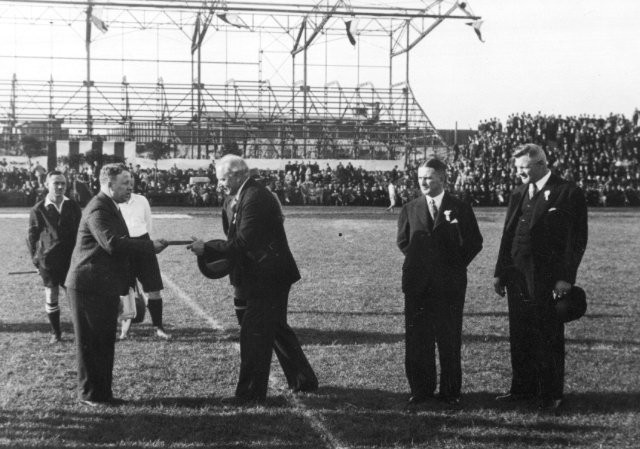
Credit: Narodowe Archiwum Cyfrowe
Ruch won a further four league titles before the war (making it 5 out of a possible 6). With Hajduki Wielkie having just been incorporated into the city of Chorzów, Ruch were also leading the table when war broke out. Around the same time the Swiss clock Omega was installed in the stadium and its first game saw Wilimowski score 10 goals, a league record that still stands today. It was hidden by Augustyn Ferda throughout the war (Ferda was a club employee who had taken part in all three of Silesian Uprisings) and it survived into the 21st century.
During WWII many Ruch players were conscripted into the German Wehrmacht. Some of them deserted (one during the battle of Monte Cassino) and following the war some came back to play for Ruch.
Following the Allied settlement at Yalta, the whole of Silesia came under Polish rule and in the years following the end of the war local clubs played a leading role. Ruch (then playing under name of Unia as the communists seemed to change everything for the sake of it) won three titles in the first decade of post-war league football. Fellow local side Polonia (Ogniwo) Bytom also picked up a title in 1954. While life became easier following Stalin’s death, the Red Army remained in the country and in 1956 over 100 people were killed during protests in Poznań.
As often happens football took on a more important role when in a World Cup qualifier in October 1957 Poland (with 8 Silesians in the squad) beat the despised USSR 2-1 at a packed Stadion Śląski in Chorzów. Both goals were scored by Ruch’s Gerard Cieślik, who only learned he was playing the previous evening from the radio and had to take a day off from Huta Batory where he worked as turner. The victory was a great moment for the oppressed nation and the crowd’s enthusiasm was so great that they broke through militia cordons and celebrated in the showers with the players.
Silesia dominated league football in the 1960s winning every title bar one with Górnik Zabrze emerging as the country’s strongest club. Created in post-WWII Zabrze (Hindenburg before the war) in 1948 by the merger of four other clubs, Górnik's name literally means 'miner' in honour of its core fanbase. The club won their first league title in 1957 and the following 11 years never saw them finish outside of the top three. This period including an unprecedented five titles on the bounce between 1963 and 1967. Their most memorable night probably came in 1970 when they fell 2-1 to Manchester City in the final of the old Cup-Winners’ Cup.
Of the players who have represented Górnik over the years the most famous is probably Włodzimierz Lubański, whose goals record for the national team was only surpassed in 2017 by one Robert Lewandowski. Lubański made his debut for Poland aged just 16 in 1963. Ten years on he was brutally fouled by Roy McFarland during a World Cup qualifier against England at the Stadion Śląski. The stadium, which was the national stadium in those days, was nicknamed the ‘Witches Cauldron’ by the English media due to the intense noise it produced. As a consequence of McFarland’s tackle Lubański didn’t play in the famous return leg at Wembley and wasn’t a part of a team that won the bronze medal at the World Cup of 1974.
Lubański learned his trade from the Polish league’s all-time record goalscorer Ernest Pohl, a man who scored 186 top-flight goals between 1953 and 1967. Górnik’s previously rather bare-bones stadium is now named after Pohl (named Pol under communism), having originally been built in 1934 as the 'Adolf Hitler Stadium'. The rebuilding of the stadium was finally completed in 2016, three years late, and currently holds 24,000 (although there are plans to raise that to 32,000).
Silesian football has struggled in the post-communist era. The last title won by a local club was in 1989 by Ruch Chorzów who had local lad Krzysztof Warzycha top scoring with 24 goals. Nicknamed “Gucio” after the character in the popular Polish cartoon Maya the Honey Bee (Pszczolka Maja), Warzycha moved on to Panathinaikos midway through the following season where he went onto score 288 goals.
The end of political era meant football clubs lost their state ‘patrons’ and those clubs backed by mining companies were hit harder than most.
In that period Górnik have come the closest to winning the title when in 1995 they failed by two points losing out to Legia Warsaw. This campaign is remembered as being very ‘controversial’ in Poland as the title came down to the final game, played between Legia and Górnik in which Górnik lost finishing the game with just eight men.
While Ruch hung around the top league, years of stagnation finally resulted in them going down in 2017 and having to be, controversially, bailed out by the city with public money.
Despite Zabrze being only the 5th largest city in the region and Chorzów not even in top 10, the other clubs in Silesia remain firmly in the shadow of Górnik and Ruch.
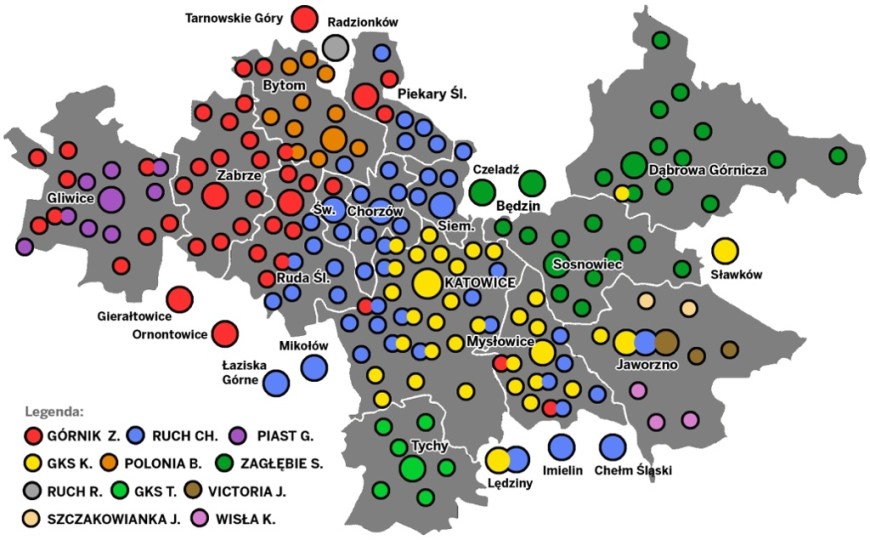
The image above shows where the various clubs support comes from in the region.
The complicated situation is even more so when you consider that technically one of the goals in GKS Katowice’s ground is in Chorzów, while Zagłębie Sosnowiec’s ground was in Katowice before a series of city boundary changes was made.
Of the other clubs in the region, Piast Gliwice are the most successful second tier side in terms of points collected but continue to live in the shadow of neighbour’s Górnik despite enjoying one of the best period’s in their history. Zabrze fan group Torcida claim half of the city of Gliwice supports Górnik for example.
Elsewhere GKS Katowice, whose fans are friends with Górnik’s, similarly struggle, if to a lesser extent than Piast trying to come out of the shadow of their more successful neighbours – Ruch Chorzów. The ‘Gieksa’ are a relatively young club having been formed by a merger of couple of Katowice clubs in 1964 (although note they have nothing to do with 1.FC Kattowitz who were already long gone by then). Their best period was between the mid-80s and mid-90s when they played European football ten years on the trot. They won the cup 3 times, finished runners-up in the league on four occasions and also finished third on four occasions too.
Zagłębie Sosnowiec, meanwhile, have won the cup four times in their history and were league runners-up but their most recent success was in the late 1970s. Zagłębie were the favourite club of Communist Party First Secretary Edward Gierek and had an often amazing ability to perform like world beaters in the second half of seasons to somehow avoid relegation. One point of interest. When in Sosnowiec don’t mention you’re in Silesia. Sosnowiec is proud to be in a different region called Zagłębie which has a different history than Silesia having been under Russian rule during the partitions of the 19th century as opposed to German.
Polonia Bytom were formed in 1945 largely by players and coaches who had fled from Lwów which became Ukrainian Lviv and remained Soviet after WWII. Polonia carry the same colors and a very similar crest as Pogoń, the most popular club in pre-war Lwów. The Bytom side are the only Polish club to have won any kind of European cup – the Intertoto in 1965 and have won the Polish league twice. Their stadium built in 1929 played host in 1942 to a match between Germany and Romania. Germany won 7-0 including a goal from Ernst Wilimowski, while the young Gerard Cieślik and Ernest Pohl, who would both become famous Polish players after the war, were in the crowd. The game and ‘Ezi’s’ appearance had a huge impact on them, Cieślik claimed Wilimowski was the best player he ever saw.
Other Silesian clubs which are found in the lower leagues but are nonetheless worth a mention include GKS Tychy who play their games in a shiny new stadium that hosted Euro U21 games in 2017. ROW Rybnik, meanwhile, are more famous for their speedway team (12-time Polish champions) than their football team. Their stadium has also hosted some big names but this time outside the world of sport with music acts such as Rod Stewart, Guns N’ Roses, Bryan Adams and Linkin Park all playing there.
GKS Jastrzębie play at a curious stadium with a grass embankment on one side of the ground. When it’s open to the public you can see the block of flats where the Polish international defender Kamil Glik grew up.
If you really want to go hardcore then pay a visit to Śląsk Świętochłowice (try not to twist your tongue saying that) a city located in the heart of Silesia. The club play their matches in a speedway stadium and regularly compete with another Silesian side, Szombierki Bytom, the Bytom team of the Silesian “Hanysy” as opposed to Polonia Bytom who are followed by the ‘refugees’ from Lwów. Szombierki were Polish champions in 1980.
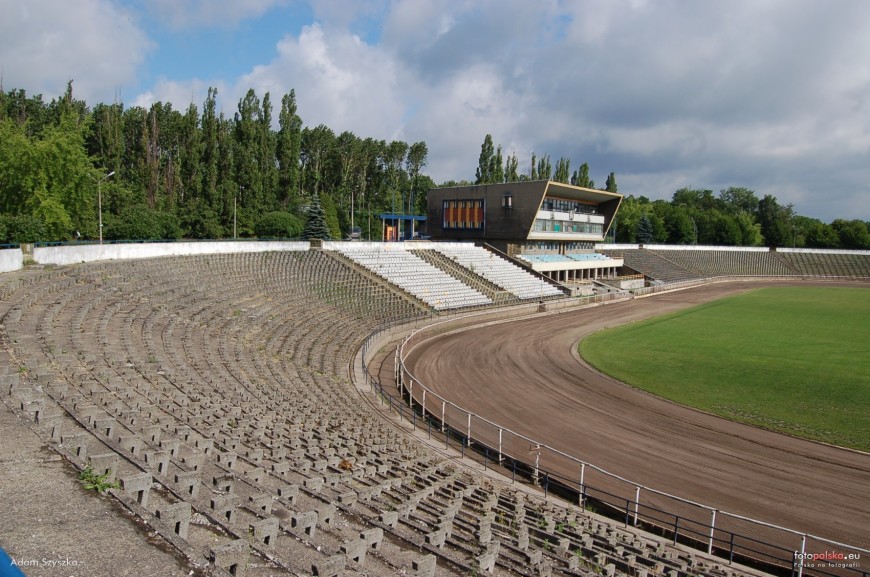
Credit: cieszyn.fotopolska.eu
We'd like to thank our Polish football expert Maciej Slominski for his help as we put this together. You can find him on Twitter @MaciejSlominski


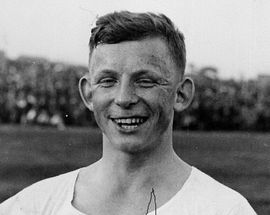
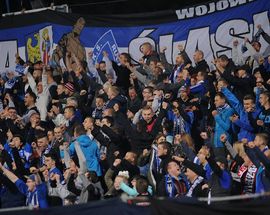
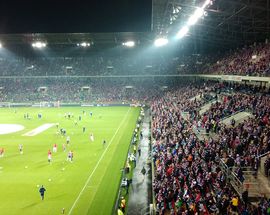
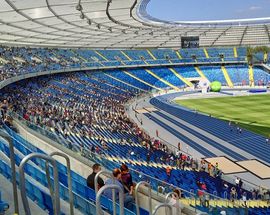
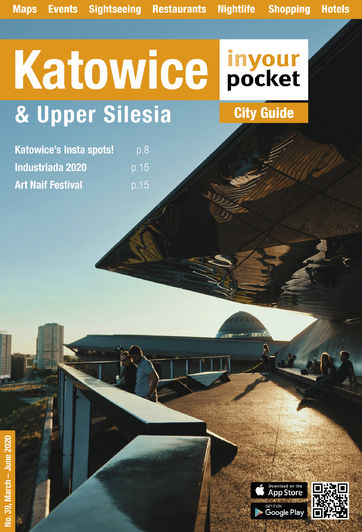
Comments